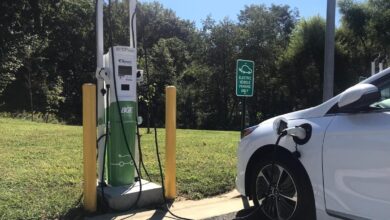Electric Vehicle Charging Infrastructure Market Size to Surpass USD 274.49 Bn by 2033

Electric Vehicle Charging Infrastructure Market Size to Surpass USD 274.49 Bn by 2033
Ottawa, May 03, 2024 (GLOBE NEWSWIRE) — According to Precedence Research, the global
electric vehicle charging infrastructure market
size was valued at USD 34.26 billion in 2023. The electric vehicle charging infrastructure market. It is driven by increased awareness, government initiatives, and advanced technologies.
Electric Vehicle Charging Infrastructure Market Revenue (USD Million), by Charger Type
|
By Charger Type |
2020 |
2021 |
2022 |
2023 |
|
Slow Charger |
1,012.9 | 1,405.0 | 1,957.6 | 2,740.7 |
|
Fast Charger |
13,883.2 | 18,108.9 | 23,800.7 | 31,517.9 |
Electric Vehicle Charging Infrastructure Market Revenue (USD Million), by Connector Type
|
By Connector |
2020 |
2021 |
2022 |
2023 |
|
CHAdeMO |
4,319.9 | 5,366.3 | 6,697.2 | 8,393.4 |
|
Combined Charging System (CCS) |
5,541.3 | 7,561.6 | 10,380.6 | 14,337.2 |
|
Others |
5,034.9 | 6,585.9 | 8,680.6 | 11,528.0 |
Immediate Delivery Available | Buy This Premium Research Report@
https://www.precedenceresearch.com/checkout/1461
The electric vehicle charging infrastructure market is the network of businesses that offer charging stations for
electric vehicles
, including hardware and software for controlling charging stations. The market deals with the manufacturing, installation, maintenance, and repair of the infrastructure. The worldwide push for environmentally friendly transportation drives
demand for electric vehicle (EV) charging stations
. The popularity of electric vehicles is predicted to rise over the next decade, thanks to technology advancements, charging infrastructure, and grid connectivity.
Further technical advances, including intelligent charging infrastructure, dependable communication systems, and coordinated charging systems, are required for EVs with distributed generators to fulfill their full potential. A future grid technology based on the Energy Internet could allow the electrical grid to become entirely automated, complete with advanced energy management technologies.
The Full Study is Readily Available | Download the Sample Pages of this Report@
https://www.precedenceresearch.com/sample/1461
Key Insights
- U.S. electric vehicle charging infrastructure market size was estimated at USD 3,530.6 million in 2022.
- The commercial segment has accounted the highest revenue share of 89.60% in 2023.
- The commercial segment was valued at USD 30,695.7 million in 2023.
- The residential application segment accounted for USD 3,562.9 million in 2023.
- China EV charging infrastructure market size surpassed USD 19,145.1 million in 2023.
- Japan EV charging infrastructure market was estimated at USD 765 million in 2023.
- South Korea EV charging infrastructure market size was evaluated at USD 430 million in 2023.
- Netherlands EV charging infrastructure market reached 2602.9 million in 2023.
- Germany EV charging infrastructure market was valued at USD 2,156.1 million in 2023.
Regional Stance
The Asia Pacific electric vehicle charging infrastructure market size is calculated at USD 28.20 and is projected to reach around USD 181.73 billion by 2033, expanding at a remarkable CAGR of 24.27% from 2024 to 2033.

Asia Pacific dominated the electric vehicle charging infrastructure market, followed by Europe and North America. China, Japan, and South Korea are Asia’s largest electric vehicle marketplaces. In these countries, the government intensively supports electric passenger automobiles. These countries have provided numerous subsidies, grants, and incentives to encourage people to transition to electric vehicles.
China controls the regional EV market due to its supremacy in EV production and consumption. Their government has taken several steps, including subsidies for EV buyers, mandatory laws requiring all car manufacturers to produce electric vehicles based on the number of cars they manufacture, widespread support for the installation of charging stations in major cities, and regulations against excessive polluting vehicles. The governments of these countries have helped to build the EV market by adopting emission limits, installing charging stations, and setting deadlines for drivers to switch from ICE cars to full or
hybrid electric vehicles
.
Europe is expected to witness growth at the fastest rate. Germany, France, the Netherlands, Norway, Sweden, the United Kingdom, and other European countries are experiencing an increase in demand for electric passenger vehicles. The transportation sector’s environmental impact has led to a need for decarbonization to meet climate goals and limit global warming. This has led to increased adoption of low-carbon technology and the shift towards zero-emission vehicles. Light-duty passenger vehicle adoption has increased, and the demand for electric vehicles is fueled by large investments by automotive giants in research, development, and production. This increase in the adoption of electric vehicles boosted the need for charging infrastructure.
You can place an order or ask any questions, please feel free to contact at
sales@precedenceresearch.com
| +1 650 460 3308
Scope of Electric Vehicle Charging Infrastructure Market
|
Report Coverage |
Details |
| CAGR | 23.13% from 2024 to 2033 |
| Market Size in 2023 | USD 34.26 Billion |
| Market Size in 2024 | USD 45.91 Billion |
| Market Size by 2033 | USD 274.49 Billion |
| Largest Market | Asia Pacific |
| Base Year | 2023 |
| Forecast Year | 2024 to 2033 |
| Historical Year | 2021-2022 |
| Segments Covered | Charger Type, Connector Type, Application Type, and Region |
| Regions Covered | North America, Europe, Asia-Pacific, Latin America, and Middle East & Africa |
Report Highlights
By Charger Type
Depending upon the charger type, the fast charger segment dominated the electric vehicle charging infrastructure market in 2023. Level 1, Level 2, and Level 3 charging stations are available, with DC fast charging stations becoming increasingly popular for long-distance driving. EV chargers offer convenience and flexibility, eliminating the need for frequent gas stations. They use renewable energy, reducing environmental pollution.
Smart charging piles can manage to charge plans and monitor costs in real time. They also promote sustainable development by supporting the construction of a sustainable transportation system. The expansion of EV charger distribution networks can provide infrastructure for the popularization and development of electric vehicles in the future.
By Connector Type
The combined charging system (CCS) segment dominated the electric vehicle charging infrastructure market in 2023. The Combined Charging System (CCS) is a popular choice among electric vehicle owners because of its adaptability, speed, and efficiency. It combines AC and DC charging capabilities, allowing you to charge at Level 2 and Level 3 stations with a single connector.
CCS enables power levels ranging from 3.7 kW to 350 kW, resulting in faster charging times. It also employs power line communication (PLC) technology to improve the charging process, decreasing energy loss and increasing efficiency. CCS is interoperable with many different
electric car
types, offering it a versatile and future-proof charging solution.
Personalized your customization here:
https://www.precedenceresearch.com/customization/1461
By Application
The commercial electric vehicle (EV) segment dominated the market and showed great potential for the future. The government has been actively encouraging the use of EVs, particularly commercial cars, through a variety of measures such as financial incentives, tax breaks, and subsidies. These steps attempt to hasten the shift to cleaner, more sustainable transportation. With the advent of e-commerce and the growing demand for last-mile delivery services, commercial EVs are becoming increasingly important.
Many businesses are already using electric vans and three-wheelers in their delivery fleets to decrease emissions and running expenses. Commercial EVs are also gaining popularity in the public transportation sector.
Market Dynamics
Drivers
Low battery cost
The cost of
electric vehicle batteries
has fallen over the previous decade as a result of technological breakthroughs and increased production volume. EV batteries are one of the most expensive components of an electric vehicle. Because manufacturing prices are falling, cathode materials are becoming more economical, and production is expanding, these batteries are becoming less expensive to produce. With the reduction in cost, people are adopting EVs, which is promoting the development of EV charging infrastructure.
Consumer Awareness
Concerns about climate change and air pollution have prompted people to seek out environmentally responsible transportation options. Lower operating costs, government incentives, technological breakthroughs, favorable public perception, and rising fuel prices are driving this trend. People are getting more and more aware via social media and other digital platforms.
Restraint
High development cost
Developing charging infrastructure is costly and requires a lot of investment to build a proper structure. For now, only developed countries are able to build proper infrastructure but are unable to cover the entire region. The high cost makes it difficult to develop infrastructure in the outskirts, which leads to range anxiety. Range anxiety reduces the use of EVs, which, again, in turn, impacts the development of charging infrastructure.
Browse More Insights:
-
Electric Powertrain Market:
The global
electric powertrain market
is expected to reach a compound annual growth rate (CAGR) 15.2% during forecast period 2023 to 2032 and predicted to hit over USD 390.31 billion by 2032. -
Off-highway Electric Vehicle Market:
The global
Off-highway electric vehicle market size
was valued at USD 14.2 billion in 2022 and is expected to reach USD 52.67 billion by 2032, with a compound annual growth rate (CAGR) of 14.6% from 2023 to 2032. -
Electric Vehicle Supply Equipment Market:
The global
electric vehicle supply equipment market size
was valued at USD 21.64 billion in 2022 and is expected to be valued at USD 364.94 billion by 2032, growing at a CAGR of 32.7% between 2023 and 2032.
-
Electric Vehicle Range Extender Market:
The global
electric vehicle range extender market size
was estimated at US$ 1 billion in 2022 and is expected to surpass around US$ 2.31 billion by 2032, poised to grow at a CAGR of 8.80% from 2023 to 2032.
-
Electric Vehicle Battery Market:
The global
electric vehicle battery market size
was valued at USD 63.51 billion in 2023 and it is expected to hit around USD 573.08 billion by 2033 with a registered CAGR of 25.1% from 2024 to 2033.
-
Electric Vehicle Charger Market:
The global
electric vehicle (EV) charger market size
was valued at USD 9 billion in 2022 and it is expected to worth around USD 105.84 billion by 2032 with a remarkable CAGR of 28% from 2023 to 2032.
-
Electric Vehicle Motor Market:
The global
electric vehicle motor market size
was worth USD 8.5 billion in 2022 and is predicted to be worth around USD 56.95 billion by 2032, expanding growth at a CAGR of 21% from 2023 to 2032.
-
Electric Vehicle Battery Swapping Market:
The global
electric vehicle battery swapping market size
accounted USD 1.80 billion in 2022 and is forecasted to reach around USD 49.70 billion by 2032 with a CAGR of 39.40% from 2023 to 2032.
-
Electric Vehicle Adhesives Market:
The global
electric vehicle adhesives market size
was valued at USD 1.40 billion in 2022 and is expected to hit around USD 11.51 billion by 2032, poised to grow at a CAGR of 23.50% from 2023 to 2032.
-
Electric Vehicle (EV) Test Equipment Market:
The global
electric vehicle (EV) test equipment market
size was valued at USD 60 million in 2022 and is expected to reach around USD 462.18million by 2032 and is poised to grow at a CAGR of 22.7% from 2023 to 2032.
-
Electric Vehicle Battery Recycling Market:
The global
electric vehicle battery recycling market size
was valued at USD 2.8 billion in 2022 and is expected to reach around USD 42.48 billion by 2032, growing at a high CAGR of 31.3% from 2023 to 2032.
Opportunity
Technological advancement
Future research ideas include converting existing grids into
smart grids
, which improve efficiency and provide a secondary income source for electric vehicles (EVs). This technique saves capital investment while ensuring network scalability, resulting in fewer outages and system deterioration. Increased battery capacity or RCS penetration in the grid is critical for improving EV adoption.
Lithium-sulfur batteries, which have a higher capacity and a longer life, are easy to manufacture and integrate into smart grids. This will alleviate range anxiety in EV drivers and make charging more convenient. Upgrading and stabilizing the grid is necessary to guarantee that it can handle the increasing demand for electric vehicles.
Recent Developments:
-
In March 2024, Mahindra, an Indian manufacturer, signed a Memorandum of Understanding with Adani Total Energies E-Mobility Ltd to create an electric vehicle charging infrastructure across India and provide e-mobility solutions to customers.
-
In March 2024, Tata Power and the Ayodhya Development Authority collaborated to provide EV charging stations in Ayodhya, a city noted for its electric vehicle (EV) infrastructure. The strategic alliance aims to accelerate the use of electric vehicles and promote environmentally friendly transportation alternatives.
-
In June 2023, Stellantis introduced Free2move Charge, a 360-degree ecosystem that will quickly supply energy management and charging to suit all EV consumer demands anytime and in any way.
Electric Vehicle Charging Infrastructure Market Key Players:
- ABB
- BP Chargemaster
- ChargePoint, Inc.
- ClipperCreek, Inc.
- Eaton Corp.
- General Electric Company
- Leviton Manufacturing Co., Inc.
- SemaConnect, Inc.
- Schneider Electric
- Siemens AG
- Tesla, Inc.
- Webasto SE
Market Segmentation
By Charger Type
- Slow Charger
-
Fast Charger
By Connector Type
- CHAdeMO
- Combined Charging System (CCS)
-
Others
By Application
By Region
- North America
- Europe
- Asia Pacific
- LATAM
-
MEA
Immediate Delivery Available | Buy This Premium Research Report@
https://www.precedenceresearch.com/checkout/1461
You can place an order or ask any questions, please feel free to contact at
sales@precedenceresearch.com
| +1 650 460 3308
Unlocking Market Insights through Data Excellence
The “Precedence Statistics” flexible dashboard is a powerful tool that offers real-time news updates, economic and market forecasts, and customizable reports. It can be configured to support a wide range of analysis styles and strategic planning needs. This tool empowers users to stay informed and make data-driven decisions in various scenarios, making it a valuable asset for businesses and professionals looking to stay ahead in today’s dynamic and data-driven world.
To Access our Premium Real-Time Data Intelligence Tool, Visit:
http://www.precedencestatistics.com
About Us
Precedence Research is a worldwide market research and consulting organization. We give an unmatched nature of offering to our customers present all around the globe across industry verticals. Precedence Research has expertise in giving deep-dive market insight along with market intelligence to our customers spread crosswise over various undertakings. We are obliged to serve our different client base present over the enterprises of medicinal services, healthcare, innovation, next-gen technologies, semi-conductors, chemicals, automotive, and aerospace & defense, among different ventures present globally.
Web:
https://www.precedenceresearch.com
Our Blogs:
https://www.towardshealthcare.com
https://www.towardspackaging.com
For Latest Update Follow Us:




